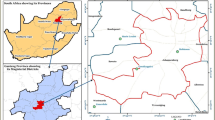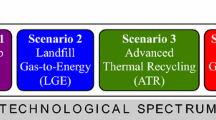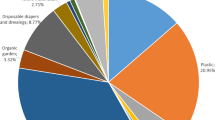Abstract
Background, aim, and scope
Management of the medical waste produced in hospitals or health care facilities has raised concerns relating to public health, occupational safety, and the environment. Life cycle assessment (LCA) is a decision-supporting tool in waste management practice; but relatively little research has been done on the evaluation of medical waste treatment from a life cycle perspective. Our study compares the environmental performances of two dominant technologies, hazardous waste incineration (HWI) as a type of incineration technology and steam autoclave sterilization with sanitary landfill (AL) as a type of non-incineration technology, for specific medical waste of average composition. The results of this study could support the medical waste hierarchy.
Materials and methods
This study implemented the ISO 14040 standard. Data on steam autoclave sterilization were obtained from an on-site operations report, while inventory models were used for HWI, sanitary landfill, and residues landfill. Background data were from the ecoinvent database. The comparative LCA was carried out for five alternatives: HWI with energy recovery efficiencies of 0%, 15%, and 30% and AL with energy recovery efficiencies of 0% and 10%.
Results
The assumptions on the time frame for landfill markedly affect the impact category scores; however, the orders of preference for both time frames are almost the same. HWI with 30% energy recovery efficiency has the lowest environmental impacts for all impact categories, except freshwater ecotoxicity. Incineration and sanitary landfill processes dominate global warming, freshwater aquatic ecotoxicity, and eutrophication of incineration and non-incineration alternatives, respectively. Dioxin emissions contribute about 10% to human toxicity in HWI without energy recovery alternatives, and a perturbation analysis yielded identical results. As regards eutrophication, non-incineration treatments have an approximately sevenfold higher impact than incineration treatments.
Discussion
The differences between short-term and long-term time frame assumptions mainly are decided by heavy metals dissolved in the future leachate. The high heat value of medical waste due to high contents of biomass, plastic, and rubber materials and a lower content of ash, results in a preference for incineration treatments. The large eutrophication difference between incineration and non-incineration treatments is caused by different N element transformations. Dioxin emission from HWI is not the most relevant to human toxicity; however, large uncertainties could exist.
Conclusions
From a life cycle perspective, the conventional waste hierarchy, implying incineration with energy recovery is better than landfill, also applies to the case of medical waste. The sanitary landfill process is the key issue in non-incineration treatments, and HWI and the subsequent residues landfill processes are key issues in incineration treatments.
Recommendations and perspectives
Integrating the medical waste hierarchy and constructing a medical waste framework require broader technologies to be investigated further, based on a life cycle approach.






Similar content being viewed by others
References
Clarke WP (2000) Cost–benefit analysis of introducing technology to rapidly degrade municipal solid waste. Waste Manage Res 18(12):510–524
Cleverly D, Schanum J, Winters D, Schweer G (1999) Inventory of sources and releases of dioxin-like compounds in the United States. Organohal Comp 41:467–472
Coutinho M, Rodrigues R, Duwel U, Päpke O, Borrego C, Schroder H (2000) The DG European dioxin emission inventory. Stage II: characterization of the emissions of 2 hospitals waste incinerators and a steel mill plant in Portugal. Organohal Comp 46:287–290
Dalemo M, Sonesson U, Björklund A, Mingarini K, Frostell B, Jönsson H, Nybrant T, Sundqvist JO, Thyselius L (1997) ORWARE-a simulation model for organic waste handling systems. Part 1: model description. Resour Conserv Recycl 21:39–54
Deng N (2005) Pyrolysis characteristics and kinetic model studies of medical solid wastes. Ph.D. thesis, Tianjin University
Doka G (2003a) Life cycle inventories of waste treatment services. Part II waste incineration. Swiss Centre of Life Cycle Inventories, Dübendorf
Doka G (2003b) Life cycle inventories of waste treatment services. Part III landfills-underground deposits-land farming. Swiss Centre of Life Cycle Inventories, Dübendorf
ecoinvent Center (2004) ecoinvent database v1.1
Eriksson O, Carlsson RM, Frostell B, Björklund A, Assefa G, Sundqvist JO, Granath J, Baky A, Thyselius L (2005) Municipal solid waste management from a system perspective. J Clean Prod 13(3):241–252
European Commission (2000) Directive 76/CE/2000, Jornal Oficial da Comunidades Europeias C25/40
European Communities (2000) Commission Decision 2000/532/EC
Ferraz AM, Afonso S (2003) Dioxin emission factors for the incineration of different medical waste types. Arch Environ Con Tox 44:460–466
Finnveden G, Johansson J, Lind P, Moberg Å (2005) Life cycle assessment of energy from solid waste-part 1 general methodology and results. J Clean Prod 13(3):213–229
Glasser H, Chang DP, Hickman DC (1991) An analysis of biomedical waste incineration. J Air Waste Manage Assoc 41(9):1180–1189
Guinée JB, Gorrée M, Heijungs R, Huppes G, Kleijn R, Koning A, de Oers L, van Wegener Sleeswijk A, Suh S, Udo de Haes HA, de Bruijn H, can Duin R, Huijbregts MAJ (2002) Handbook on life cycle assessment. Operational guide to the ISO standards. Springer, Heidelberg
Haastrup P, Maniezzo V, Mattarelli M, Rinaldi FM, Medes I, Paruccini M (1998) A decision support system for urban waste management. Eur J Oper Res 109(2):330–341
Heijungs R, Kleijn R (2001) Numerical approaches towards life cycle interpretation. Five examples. Int J LCA 6(3):141–148
HYDROCLAVE Systems Corp. (1998) www.hydroclave.com
ISO (2006) Environmental management-life cycle assessment-principles and framework. International Standard ISO 14040
Kuo HW, Shu SL, Wu CC, Lai HS (1998) Characteristics of medical waste in Taiwan. Water Air Soil Poll 114:413–421
Lee BK, Ellenbecker MJ, Rafael ME (2004) Alternatives for treatment and disposal cost reduction of regulated medical wastes. Waste Manage 24:143–151
McDougall FR, White PR, Franke M, Hindle P (2001) Integrated solid waste management: a life cycle inventory, second edn. Blackwell, London
Moberg Å, Finnveden G, Johansson J, Lind P (2005) Life cycle assessment of energy from solid waste-part 2 landfilling compared to other treatment methods. J Clean Prod 13(3):231–240
Mohee R (2005) Medical wastes characterisation in medical institutions in Mauritius. Waste Manage 25(6):575–581
Park HS, Jeong JW (2001) Recent trends on disposal technologies of medical waste. J Korean Solid Wastes Engineering Soc 18(1):18–27
SEPA (1998) National catalogue of hazardous wastes.
USEPA (1988) Medical waste tracking act.
USEPA (1997) Study report to Congress. Volume II: an inventory of anthropogenic mercury emissions in the United Sates.
UK Statutory Instrument (2005) Hazardous waste (England and Wales) regulations.
Wollny W, Dehoust G, Fritsche UR, Weinem P (2002) Comparison of plastic packaging waste options. Feedstock recycling versus energy recovery in Germany. J Indus Ecol 5(3):49–63
Acknowledgement
This work was supported in part by the Asia-Link project “Human Resources Development for the improvement and protection of Environment in Asia” (ProtEA). No. CN/ASIA-LINK (110-744).
Author information
Authors and Affiliations
Corresponding author
Additional information
Responsible editor: David Pennington
Electronic supplementary material
Below is the link to the electronic supplementary material.
ESM 1
(DOC 102 KB)
Rights and permissions
About this article
Cite this article
Zhao, W., van der Voet, E., Huppes, G. et al. Comparative life cycle assessments of incineration and non-incineration treatments for medical waste. Int J Life Cycle Assess 14, 114–121 (2009). https://doi.org/10.1007/s11367-008-0049-1
Received:
Accepted:
Published:
Issue Date:
DOI: https://doi.org/10.1007/s11367-008-0049-1




